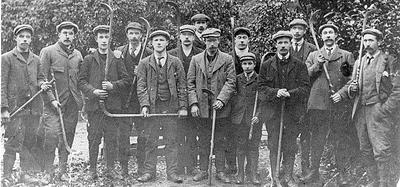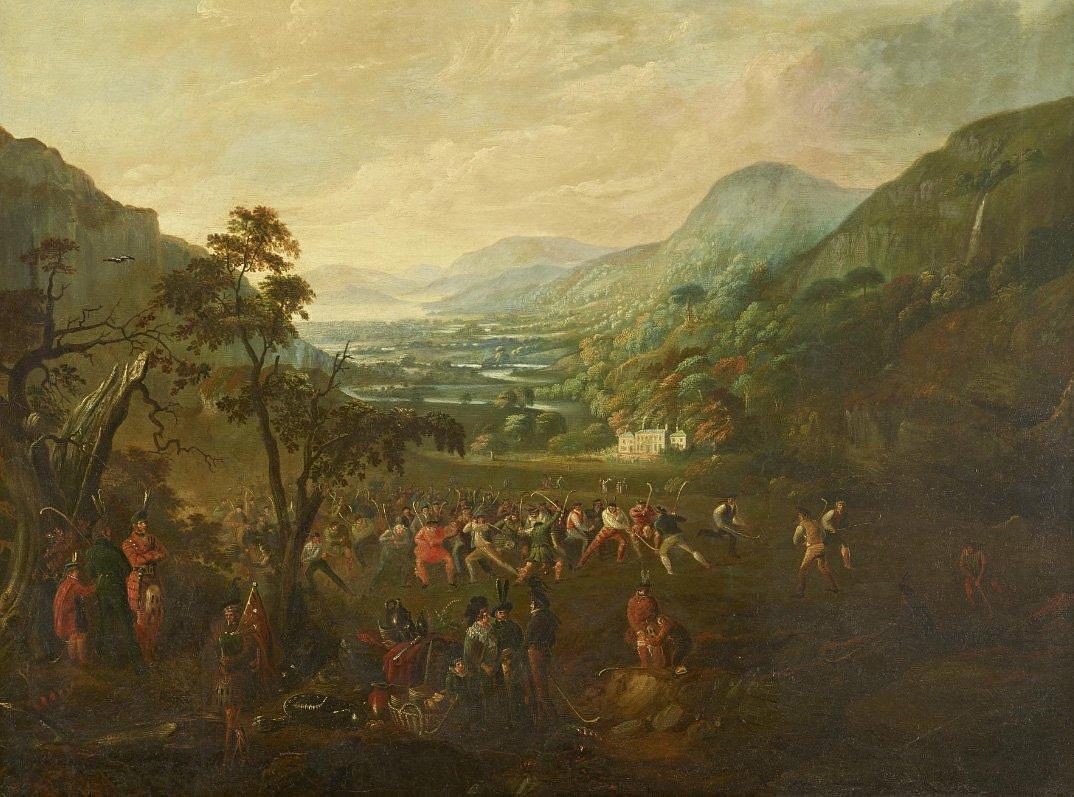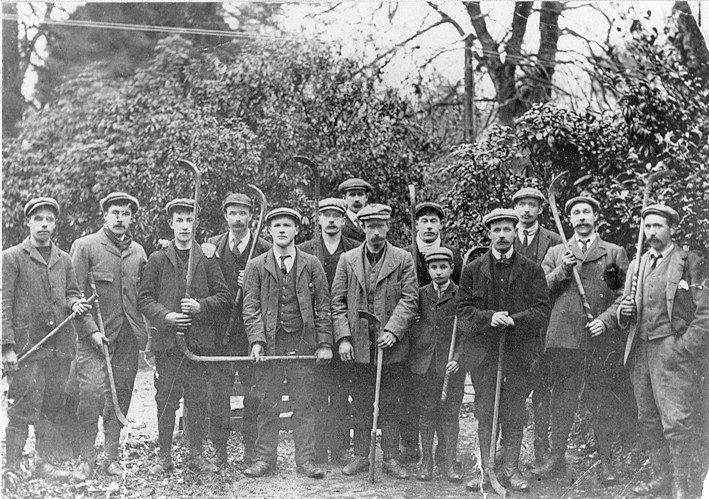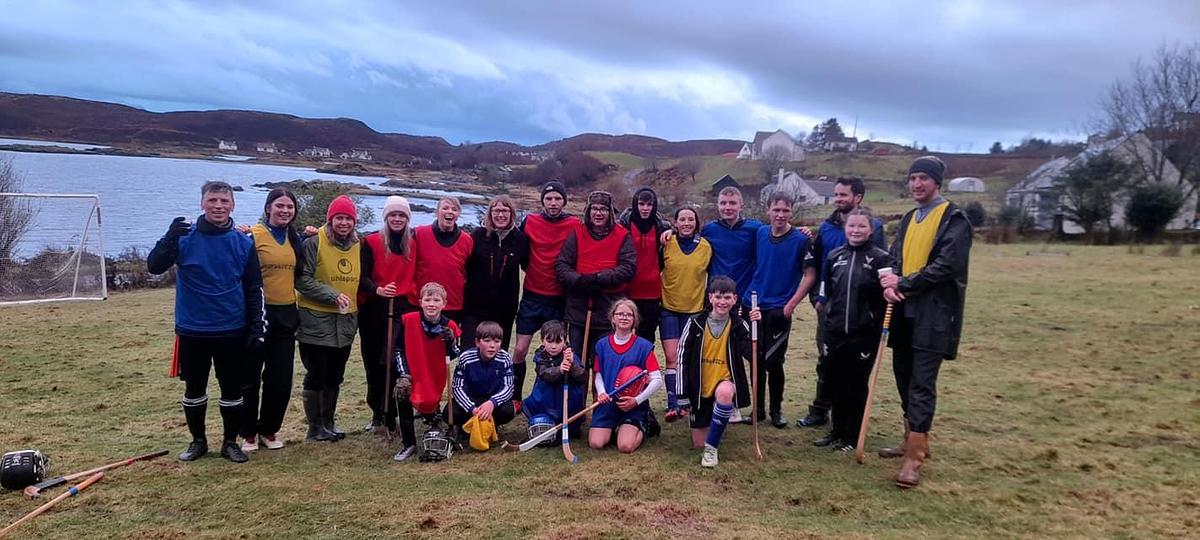
A new year and an old sporting tradition
Shinty at new year – on dates as according to both the Julian and the Gregorian calendar – is a long established Highland tradition, remembered in various accounts archived online by the Tobar an Dualchais project, as West Highland Free Press editor Keith MacKenzie discovered…

S iad gillean mo rùin a thogadh mo shunnd;
’S i seo a’ Bhliadhn’’ Ùr thug sòlas duinn.
‘These darling lads are an inspiration – they made this new year a cause for celebration’.
So wrote the famed Skye bard Màiri Mhòr nan Òran, big Mary MacPherson of the songs, in what singer Mary Ann Kennedy described as a part song, part match commentary, on a New Year shinty match played by exiled Gaels in Glasgow’s Queen’s Park in 1876.
That 30-a-side game – one team in kilts and the other in knickerbockers – is one of the most well-known examples of the widely-practiced Hebridean and Highland custom of playing shinty at New Year in a tradition that pre-dates the development of the organised version of the sport played today.
There were also written lowland accounts of shinty at New Year much earlier in the 19th century – The Edinburgh Courant carried an account of “camack” being played on 1st January 1821, and the earliest mention of an organised club was the North of Spey Shinty Club in Aberdeen which met on the links on New Year’s Day 1849 “for conducting the long-established Celtic Game”.
Long-established is a key-phrase, and as the Victorians edged towards the creation of formal rules, clubs and organised competition, still the New Year date was significant.
At New Year in 1878 – a full 18 years before the sport’s Camanachd Cup was established – Inveraray took great delight in avenging the previous year’s “Scottish Championship” defeat to Vale of Leven, scoring 12 goals against a club known to have declared themselves ‘champions of the world’.
Vale, incidentally, were also early football pioneers – winning the Scottish Cup three times in addition to lifting shinty’s oldest trophy, the Glasgow Celtic Society Cup, between 1877 and 1880.
To digress slightly – there’s a school of thought that suggests the positional play as learned by those like the Vale of Leven men who had played shinty could have influenced the Scots-driven evolution of football as a ‘combination passing’ game from the 1870s onwards.
Whatever the truth, the then revolutionary idea that teams would fare better through passing and positional play – as opposed to the running style which up to that point had characterised the sport in England – caught on in the latter part of the 19th century.

It would then spread as association football travelled across the globe.
That’s all another story and another debate.
As far as community accounts of shinty as a feature of traditional New Year festivities are concerned, Tobar an Dualchais online has several interesting recollections – from Skye, to Uist, Tiree, Wester Ross and Argyll.
Finlay Finlayson, a fisherman from Kyleakin, was recorded in 1961 recalling his own childhood further north in Skye, in the island’s great shinty cradle of Braes at the turn of the century (Track 6865).
There, he said, the New Year was always marked on the date of the Julian calendar, on the 12th and 13th of January.
“We hadn’t Hampden or Ibrox Park” he said, but play between townships would take place “on the levellest field they could find” and involve “all the able bodied men, from the age of 30 downwards.”
That observation gives a clue as to why the practice died out in so many places – for even the flattest field can’t host a game without young folk to play.
Another contributor, identified as Miss Campbell, from Glassary in Argyll, recalled the village’s last local New Year match played in 1937.
“There was one in 1937,” she said (Track 3386). “Then my aunt, Miss Arbuthnot, who owned the estate, died just before Christmas in 1938 and it was decided not to have one that year out of respect for her. And then of course the next year, the war started.”
In Tiree, meanwhile, there are accounts of shinty – or something very like it – being played in the years before the First World War.
James MacDonald, who was born in 1897, recalled matches on Balephuil Machair.
“There used to be kind of a sport – Iomain Chamain they called it, but that died out and now there’s nothing but drinking all day!,” he said in an interview carried out in 1975 (102548).
“I couldn’t tell you very much about it but it was in existence. That was their hobby on New Year’s Day.
“I believe it was all over the Highlands in these days, the same game. But nobody can play it now. They had a wee ball like a golf ball…..I saw that ball. Maybe if anybody had one of these balls it would be worth a lot of money now.
“I would be 14 or 15 when it stopped. It would have been 1910 or 1912.”
Another Tirisdeach, Donald Sinclair from West Hynish, who was born in 1885, had more recollections of the New Year battles – which he suggested were played a week or so after the 1st, perhaps in keeping with the Julian calendar date.
Christmas Day was not marked, he added.
The shinty matches were played six-a-side, involving players from Barrapol and Balephuil and he noted that when they played “every man was to stand in his own place to watch the ball…. Every man was watching his own quarters.” (There’s that positional play again?!).
He added in the 1971 interview (Track 50764): “It was a great day, there was plenty of whisky and plenty of ruffians too – they were wild men.
“In my father’s time there was an old Christian man –when the shinty would start he would walk down among the boys and he would bless them. ‘See and be good boys and don’t drink and don’t be fighting’….
“He didn’t disapprove, as long as they would keep sensible and sober.”
The beach was the location for matches on the east side of Lewis involving those from Tong, Steinish and Melbost. Annie MacLeod recalled in 1958 that the boys got sticks from a friendly gardener at the Castle Grounds in Stornoway, and made a ball by making a fire and heating old shoes to release the glue from the soles.
After the tide went out on New year’s day “Bha am batal a’ tòiseachadh an uairsin”, the battle would then start. (Track 31693).
Other accounts document New Year shinty in Gairloch, Knoydart, Mull and North Uist – the latter where in 2007 a cup that had been in the possession of Skye shinty stalwart DR MacDonald was contested again, a whole century after the last fixture between Tigharry and Solas.
Today New Year shinty survives in a variety of forms.
The most well-known and prestigious fixture is the Lovat Cup, first established in 1904 and played for every New Year between local rivals Beauly and Lovat.
There are fixtures in Badenoch, Lochaber and Oban, while in Glenfinnan, in the shadow of the Jacobite monument, they still play to mark the Old New Year.
In Heaste in Skye, for many years locals have marked the 1st of January with a shinty match where the trophy is a set of antlers.
And this year in Camuscross, where I live, a healthy contingent of players took part in a series of matches for a new local trophy.
Just as in Glasgow 150 years earlier, a piper played them on the park and there was plenty opportunity for spectators to toast in the new year while they watched on from the sidelines.
“’S e ’n sealladh as brèagh’ a chunnaic mi riamh,
Gach òigfhear gun ghiamh, ’s a chòta dheth.
Gach fleasgach gun mheang ’s a chaman na làimh,
’S a chnapag le srann ga fògar leo.
“And what a beautiful sight – each young man, coat off and each flawless youth,
“stick in hand with the ball whizzing away from them,”

Perhaps others would be better judging if Màiri Mhòr’s words for Queen’s Park Glasgow in 1876 could in any way apply to croft 22 Camuscross on 2nd January 2023 – but one important detail is certainly different.
The latest revival of the old custom of new year shinty included several female players, including the inaugural winning captain.
Be in no doubt Màiri Mhòr would have heartily approved….
With credit to sources: ‘Màiri Mhòr nan Òran’ ed. Donald E. Meek, and Shinty! Hugh Dan Maclennan for some of the examples featured in this article.